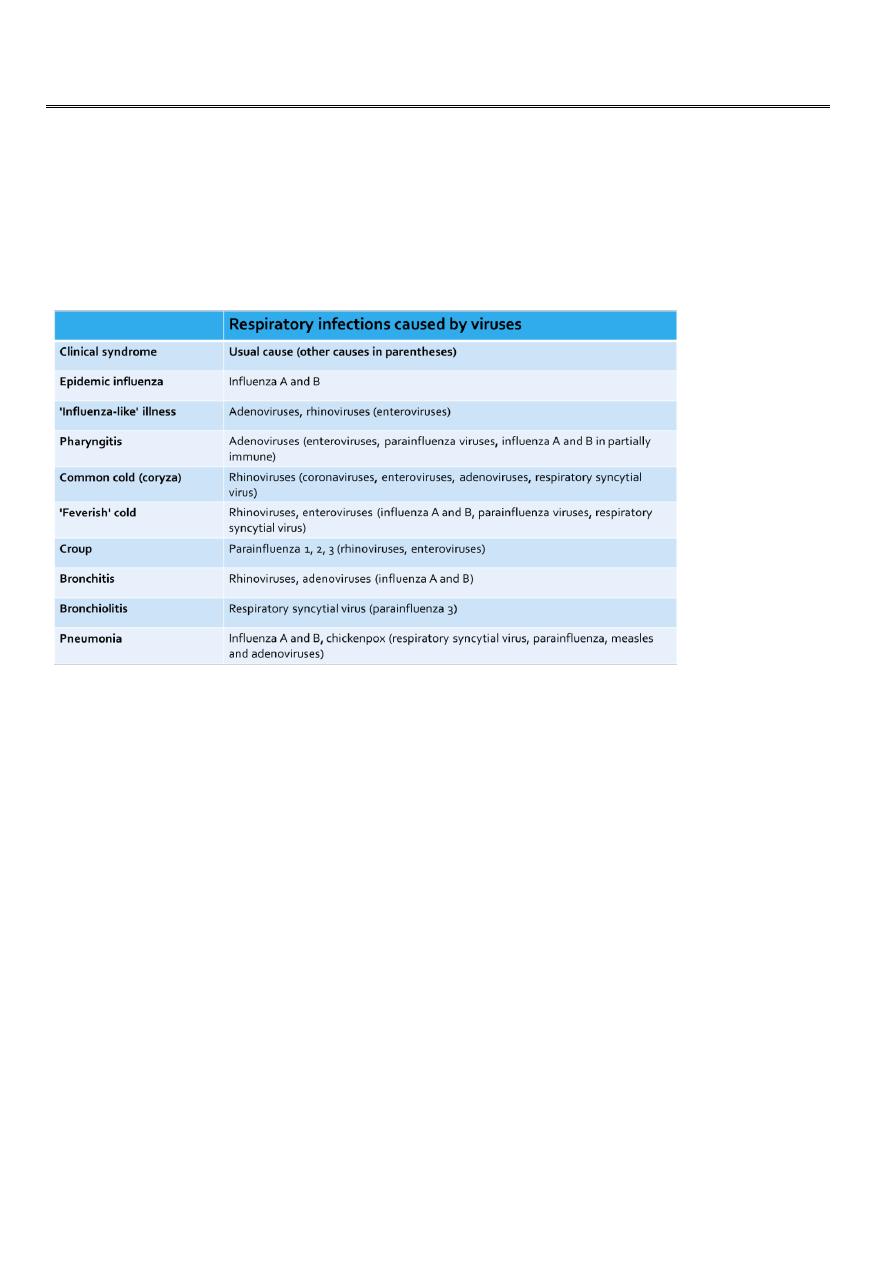
1
Forth stage
Medicine
Lec-5
.د
رامي
1/1/2014
Upper respiratory tract infection
The vast majority of these illnesses are caused by viruses , of which acute coryza (common
cold) is by far the most common. Immunity is short-lived and virus-specific. Bacterial
infection is the usual cause of acute tonsillitis, otitis media and epiglottitis.
Acute epiglottis represents a medical emergency because of the risk of asphyxia, requiring
prompt diagnosis and treatment, but those with other upper respiratory tract infections
recover rapidly and specific investigation is rarely warranted. Viruses can be isolated from
exfoliated cells collected on throat swabs, and may be identified retrospectively by
serological tests. Throat swabs may also be helpful if streptococcal pharyngitis is suspected,
and a blood film and serological testing will identify infectious mononucleosis. X-rays of the
sinuses may be required if an underlying chronic sinusitis is suspected.
Common upper respiratory tract infections:
Acute coryza (common cold) :
Clinical features :Rapid onset. Sneezing.
Sore throat. Watery nasal discharge.
Cough (Similar features in nasal allergy)

2
Complications :Sinusitis, bronchitis, pneumonia. Hearing impairment, otitis media due to
blockage of Eustachian tubes
Management :Treatment not usually required. Paracetamol 0.5-1 g 4-6-hourly. Nasal
decongestant. Antibiotics not necessary if uncomplicated .
Acute pharyngitis:
• Clinical features:More severe sore throat. Hoarse voice or loss of voice with pain on
speaking. Painful and unproductive cough. Stridor in children, caused by
inflammatory oedema leading to partial obstruction of a small larynx
• Complications:Rare. Chronic laryngitis, tracheitis, bronchitis or pneumonia
• Management:Rest voice. Paracetamol 0.5-1 g 4-6-hourly for relief of discomfort and
pyrexia. Steam inhalations may help. Antibiotics not necessary if uncomplicated.
Sinusitis:
• Clinical features: Fever. Severe unilateral pain over maxillary or other sinus. Purulent
nasal discharge. Commonly viral, but bacterial (e.g. Strep. pneumoniae, H. influenzae)
likely if persists 7-10 days
• Complications: CNS or orbital spread of infection
• Management: Steam inhalation and nasal decongestants. Co-amoxiclav if bacterial
cause suspected.
Acute laryngo-tracheobronchitis (croup):
• Clinical features: Sudden paroxysms of cough accompanied by stridor and
breathlessness. Contraction of accessory muscles and indrawing of intercostal
spaces. Cyanosis and asphyxia in small children
• Complications: Death from asphyxia. Superinfection with bacteria, especially Strep.
pneumoniae and Staph. aureus. Viscid secretions may occlude bronchi.
• Management: Steam inhalations and humidified air/high concentrations of oxygen.
Endotracheal intubation or tracheostomy may be required to relieve laryngeal
obstruction and allow clearing of bronchial secretions. Intravenous co-amoxiclav or
erythromycin for serious illness. Maintain adequate hydration .

3
Acute epiglottitis:
• Clinical features :Mostly affects young children. Fever and sore throat, progressing to
stridor and dysphagia caused by swelling of epiglottis and surrounding structures.
Due to H. influenzae type b
• Complications: Death from asphyxia, which may be precipitated by attempts to
examine the throat-avoid using a tongue depressor or any instrument unless facilities
for endotracheal intubation or tracheostomy are immediately available
• Management: I.v. co-amoxiclav or chloramphenicol therapy essential.
Urgent endotracheal intubation or tracheostomy may be necessary
Acute bronchitis and tracheitis:
• Clinical features: Often follows acute coryza. Initial dry, painful cough with
retrosternal discomfort in tracheitis. Chest tightness, wheeze and breathlessness if
bronchitis develops. Sputum is initially scanty or mucoid, then becomes
mucopurulent, more copious and, in tracheitis, often blood-stained. Acute bronchitis
may be associated with a pyrexia of 38-39°C. Spontaneous recovery occurs over a
few days
• Complications: Bronchopneumonia. Exacerbation of asthma or COPD which, if
severe, may result in type II respiratory failure
• Management: Specific treatment rarely necessary in previously healthy individuals.
Amoxicillin 250 mg 8-hourly should be given to those developing bronchopneumonia.
Cough may be eased by pholcodine 5-10 mg 6-8-hourly. In COPD and asthma,
aggressive treatment of exacerbations may be required .
Influenza:
• Clinical features: Range from mild to rapidly fatal. Sudden onset of pyrexia with
generalised aching, headache, anorexia, nausea and vomiting, and harsh
unproductive cough. Most recover within 3-5 days, but may be followed by 'post-viral
syndrome' with debility that persists for weeks. During epidemics, diagnosis is usually
obvious. Sporadic cases diagnosed by virus isolation, fluorescent antibody techniques
or serological tests for specific antibodies
• Complications: Tracheitis, bronchitis, bronchiolitis and bronchopneumonia.
Secondary bacterial invasion by Strep. pneumoniae, H. influenzae and Staph. aureus

4
may occur. Rarely, toxic cardiomyopathy (may cause sudden death), encephalitis,
demyelinating encephalopathy and peripheral neuropathy
• Management: Bed rest. Paracetamol 0.5-1 g 4-6-hourly. Pholcodine 5-10 mg 6-8-
hourly for cough. Specific treatment for pneumonia may be necessary. Antiviral
agents (e.g. zanamivir) reduce the rate of viral replication and may be effective when
used as an adjunct to vaccination. Antiviral resistance is a potential problem.
